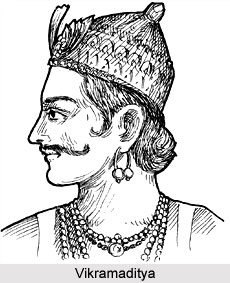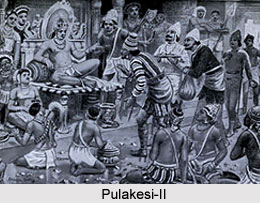 History of Pattadakal has immense richness among the people. Satavahana coin from Aihole and a few copper coins of the Marathi from Pattadakal indicate the probable political suzerainty of the Satavahanas around the beginning of the Common Era over this region. The succeeding early Kadambas had extended their political authority up to the Malaprabha and a little beyond as is known from their epigraphical records. The naturally defensive environment, traditional sanctity and economic prosperity of this region must have attracted and prompted the budding, enterprising and heroic Chalukyas to seek their political fortune here. They succeeded in their efforts around the beginning of the 6th century in the region of Badami. The Chalukyas here seemed to have set up their political hegemony easily. Jayasimha, probably the founder, carved out a region and ruled. He was immediately followed by Ranaraga who expanded and consolidated the kingdom.
History of Pattadakal has immense richness among the people. Satavahana coin from Aihole and a few copper coins of the Marathi from Pattadakal indicate the probable political suzerainty of the Satavahanas around the beginning of the Common Era over this region. The succeeding early Kadambas had extended their political authority up to the Malaprabha and a little beyond as is known from their epigraphical records. The naturally defensive environment, traditional sanctity and economic prosperity of this region must have attracted and prompted the budding, enterprising and heroic Chalukyas to seek their political fortune here. They succeeded in their efforts around the beginning of the 6th century in the region of Badami. The Chalukyas here seemed to have set up their political hegemony easily. Jayasimha, probably the founder, carved out a region and ruled. He was immediately followed by Ranaraga who expanded and consolidated the kingdom.
However, not much is known about these two Chalukyan kings. It was Pulakesi, the third king in the genealogical line, who made Badami, the capital of the kingdom in 543 and built a fort on the top of what is now known as the North hill. He was a powerful king who performed the traditional Asvamedha and other sacrifices of Vedic tradition and made costly Hiranyagarba gifts, a dazzling sign of his absolute imperial power. His son, Kirtivarma (I) with the assistance of Mangalesa his younger brother, conquered the neighbouring kingdoms of the Kadambas in the southwest, the Mauryas of the Konkana, the Kalachuris etc., and amassed enormous wealth, a good part of which was donated to the Makutesvara (i.e. Mahakutesvara) in Hosa- Mahakuta. It was his celebrated grandson Pulakesi II who extended the political boundaries of the kingdom far and wide from Narmada River to Kaveri River. He installed his younger brothers Jayasimhavarma in the north comprising Gujarath region and Jubja Vishnuvardhana in the eastern division while he ruled the central part from Badami.
However, he met with a crushing defeat at the hands of Pallava Narasimhvarman of Kanchi in 642. Badami was `terra incognito` for the next twelve years. In 654 Vikramaditya I, Pulakesi`s son, succeeded in re-conquering the kingdom from the Pallavas. The kingdom grew further and was prosperous, strong and generally peaceful under the next three rulers in succession namely: Vinayaditya, Vijayaditya and Vikramaditya II in spite of their frequent, successful wars particularly with their arch enemy, the Pallavas and others in the north. Kirtivarman II, the son of Vikramaditya II though capable and experienced in wars and administration, succumbed to the 756 onslaught by Dantidurga, the Rashtrakuta chief ruling the Ellora region. This ended the Badami Chalukyan rule. The Badami region thus became a part of the Rashtrakuta kingdom.
During the new regime a few temples such as the Traipunisha in Bachangudda and the Jain and Chandrasekhara Temples in Pattadakal, the Alii Basappa in Aihole were constructed. By 873 the Chalukya still then keeping a low profile at the appropriate occasion seized and rose to power supplanting the Rashtrakutas.
Later Kalyana in Bidar district, Karnataka had the fortune of becoming the capital of the kingdom and continued to be so till the ruling dynasty fell in about 1189. Badami never attained supremacy as before all through the ages. However, Pattadakal gained some importance by becoming the headquarters of an administrative division known as Kisukadu ruled by Nolamba Pallava Permanadi Singhanadcva as Mandalika (feudatory) under Someshvara II, Bhuvanaikamafla, the Chalukyan king, around 1070 and hundred years later by Chavumda II of the Sindha family, a mandalika to Noormadi Taila III the Chalukyan king. Chavumda`s senior queen Demaladcvi and their son Achideva by virtue of his position as prince were then enjoying Pattadakal. Aihole continued to flourish as the centre of the merchants` guild celebrated as "Ayyavole Ainurvvaru" all over south India. The region subsequently formed a part of the Sevunas of the Devagiri (i.e. modern Dauiatabad), the Vijaynagar Empire, the Maratha and Tipu Sultan`s kingdoms. Tipu constructed a fort on the South hill in Badami.
From about the beginning of the Common Era, therefore, with the increasing prosperity in the region, what was basically needed was sustained political security, well-built and organised administration, harmonious and liberal patronage on the part of the rulers, administrators and the wealthy with taste and appreciation for art and letters. All these were steadily provided in succession for nearly 600 years by the Satavahanas, the early Kadamba, and especially the most powerful Chalukyas whose capital was Badami, their kingdom extending from the Narmada to Kaveri. And this congenial situation prompted exceptional men of art and letters from the north and the south to seek patronage in these centres.
Consequently, for nearly 200 years magnificent monuments of various traditions, forms and styles, some with classical paintings of great beauty and superb workmanship, went on to be created all over the area and remained pre-eminent through the centuries.
From about the latter part of seventh century, Pattadakal grew into a unique centre of distinct and chief temple models. On the left bank of the river arc located nine temples near one another roughly in the north-south alignment. About hundred metres away from the temple complex at the northern end is the Badami - Aihole main road. On the western side is the local road leading to the village nearby. Moving from Badami to Pattadakal, it is worthwhile to visit on the way Hosa and Hale Mahakutas with painted rock shelters, structural temples of three main models the rekhanagara, the dravida-imana and the Kadamba Nagara i.e. phamsana orpidha of the Indian stupa sastra, with an oblong pond as known from the pillar inscription having a perennial water source all located in the hilly wild green grove.
 Nearer Pattadakal about a kilometre northwards is a large hill valley having wide open rock-shelters in B.N. Jalihal. In the valley and the wide shelter are about six small shrines. In the shrines are sculptures of the deities such as Bhutamata, four armed Nagaraja of rare iconographic forms, Lajjagauri and Shiva-Linga. Interestingly enough the biggest of the shrines carries an inscription engraved on the front wall indicating that the shrine is the receptacle of Vikramaditya II caused to be built by Benamma. The temple site therefore is the royal cemetery, the only one of its kind known so far in ancient Karnataka. Almost at the western outskirts of the village Pattadakal, is Bachangudda, an isolated high hill with a rounded top. On the summit of the hill is a temple of the early Rashtrakuta dedicated originally to Lord Brahma, Lord Vishnu and Lord Shiva (Traipumsha).
Nearer Pattadakal about a kilometre northwards is a large hill valley having wide open rock-shelters in B.N. Jalihal. In the valley and the wide shelter are about six small shrines. In the shrines are sculptures of the deities such as Bhutamata, four armed Nagaraja of rare iconographic forms, Lajjagauri and Shiva-Linga. Interestingly enough the biggest of the shrines carries an inscription engraved on the front wall indicating that the shrine is the receptacle of Vikramaditya II caused to be built by Benamma. The temple site therefore is the royal cemetery, the only one of its kind known so far in ancient Karnataka. Almost at the western outskirts of the village Pattadakal, is Bachangudda, an isolated high hill with a rounded top. On the summit of the hill is a temple of the early Rashtrakuta dedicated originally to Lord Brahma, Lord Vishnu and Lord Shiva (Traipumsha).
Moving further eastwards some distance by the road on the right side arc imposing rude stone megalithic monuments of two types: the port-hole and the passage chambers of the Early Iron Age. The former is a north south oriented double chambered large tomb. Oblong in plan, built with large pinkish granite stone slabs, set on the edge in vertical position in a manner that the upright stone slabs abut one another, without any binding material. On the top is a single large slab (cap stone) kept horizontally that outstretches on all sides. Inside the chamber another slab is set across in an upright position dividing it into two parts. It has a larger squares port-hole at the centre. Originally on the exterior side of the tomb around was a heap of rubble stones up to the capstone. The whole structure was thus a small hemispherical mound, but owing to vandalism the heap was disturbed and the chamber was exposed. The sub chamber on the north had collapsed to the ground level. What is extant now is roughly half the part of a large megalithic tomb about 3000 years old. The other one nearby is a rectangular chamber of red sand stone with a passage on the front side originally, now missing.



















